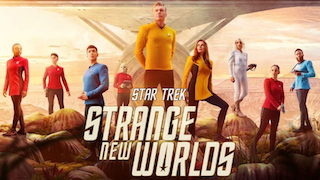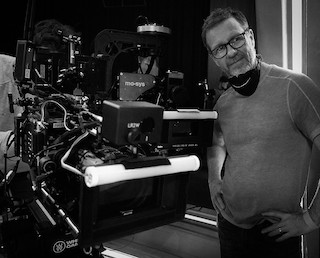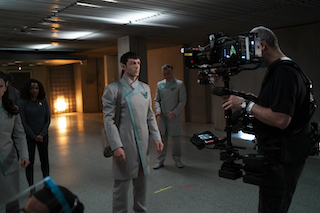Star Trek: Strange New Worlds is spin-off from Star Trek: Discovery and a prequel to Star Trek: The Original Series, Strange New Worlds follows Captain Christopher Pike and the crew of the USS. Enterprise. Cinematographer Glen Keenan, CSC, wanted to give the show the most organic, non-studio look to convince the audience they were seeing a real location.
 To accomplish that, he shot with Cooke Optics Anamorphic/i Full Frame Plus Special Flare lenses in 2.39:1 for streaming.
To accomplish that, he shot with Cooke Optics Anamorphic/i Full Frame Plus Special Flare lenses in 2.39:1 for streaming.
“For Star Trek, there’s a studio, but no reality,” said Keenan. “I want to convince the audience that we are in a real space with a lens that would add more organic qualities to the image. The Cooke anamorphic special flares have the right amount of aberrations and flare for the signature Star Trek blue streak flare. Two things really help with reality: the expected inconsistencies between lenses help to ground the story like we were really there and the anamorphic falloff. Both of those features help to deliberately frame the action to where I want the audience to focus on.”
 The offer for Keenan to move to Star Trek: Strange New Worlds and develop the look came from Alex Kurtzman, creator, and executive producer of Star Trek: Discovery. “I worked with Alex during Sleepy Hollow, and I was already in Toronto with an opening in my schedule which is how I got Disco,” said Keenan. “Alex had a bunch of projects, but he wanted me for Strange New Worlds. It struck the right chord, with an element of change that I wanted mentally and visually to get to the audience.”
The offer for Keenan to move to Star Trek: Strange New Worlds and develop the look came from Alex Kurtzman, creator, and executive producer of Star Trek: Discovery. “I worked with Alex during Sleepy Hollow, and I was already in Toronto with an opening in my schedule which is how I got Disco,” said Keenan. “Alex had a bunch of projects, but he wanted me for Strange New Worlds. It struck the right chord, with an element of change that I wanted mentally and visually to get to the audience.”
While Star Trek: Discovery was an HD production, Keenan had bigger plans for Star Trek: Strange New Worlds.
“There was a moment when shooting Disco in anamorphic that I knew I really wanted full frame special flare for 4K for Strange New Worlds. My supplier got on the horn with Cooke. And Cooke built a custom set for Strange New Worlds, delivering two sets before episode one, then the third set once they were made. Cooke stepped up with full frame anamorphic special flare for day one. It was remarkable. Three sets in two months.”
 Star Trek: Strange New Worlds’ three sets of Anamorphic/i Full Frame Plus Special Flare lenses consisted of the 32mm, 40mm, 50mm, 75mm, 85mm Macro, 100mm and 135mm for three Arri Alexa LF and four Arri Alexa Mini LF cameras.
Star Trek: Strange New Worlds’ three sets of Anamorphic/i Full Frame Plus Special Flare lenses consisted of the 32mm, 40mm, 50mm, 75mm, 85mm Macro, 100mm and 135mm for three Arri Alexa LF and four Arri Alexa Mini LF cameras.
“During episode seven, I discovered the macro on the 85mm for close-up work,” said Keenan. “It became our favorite close-up lens as it’s just lovely with great falloff. Our main lens was the 40mm which can be seen in every episode and then the 75mm for our Steadicam, where the full frame anamorphic allows me to have a great focal range. Steadicam helps tell the story well and gives you a nice shot that you don’t have to edit.”
 Unlike other current Star Trek series, Star Trek: Strange New Worlds is more in tune with Star Trek: The Original Series with each episode standing on its own, and thus were shot out of sequence. Keenan shot episodes 1, 2, 4, 7 and 9, with cinematographer Magdalena Górka shooting episodes 3, 5, 6, 8 and 10.
Unlike other current Star Trek series, Star Trek: Strange New Worlds is more in tune with Star Trek: The Original Series with each episode standing on its own, and thus were shot out of sequence. Keenan shot episodes 1, 2, 4, 7 and 9, with cinematographer Magdalena Górka shooting episodes 3, 5, 6, 8 and 10.
“With me shooting episodes 1 and 2, it helped us to set the tone for the series,” said Keenan. “This really is more like the original series. You can see it in the main themes of our show runners and the nostalgic quality of the sets, wardrobe, characters, and photography. We’re being as honest as you can be to a show shot in the ‘60s with a minimal budget. When talking with my crew – camera, lighting and rigging – we look at our problems as though we’re in the ‘60s. We have a lot of tools, but that doesn’t mean we should use everything and abuse it. The Disco approach has the camera always moving and being aggressive with cameras spinning in every episode. We’re different. It’s a living space and we don’t get in the way unless called for by the script, which allowed me to go for a bigger camera – with variations in episodes based on the scripts. Thematically, we take an episode and devise the lighting scenario for that. Our challenge was to make it its own version of the Star Trek Universe. Even the language of this show is just different enough to give it its own voice.”
Lighting Star Trek: Strange New Worlds is an elaborate process, according to Keenan. “The set’s not ready until the lighting is ready. We’ve got over two million LEDs embedded in the sets, with five lighting boards and four operators rotating between setup, shoot and programming. What works is when the set lights the actors. We’re always in an artificial space that’s not real. Our challenge is to make it real. The more they’re lit with the ship, the more real it is. Any other lighting is minimal.”
In addition to the Cooke Anamorphic/i Full Frame Plus Special Flare lenses themselves, Cooke’s /i Technology lens metadata was an extra feature that Keenan appreciates.
“I always have the data [and am] always pulling that data for post,” said Keenan. “I knew everything about that camera and could police it. I don’t think I could do a show without it. I’m addicted to it.”
